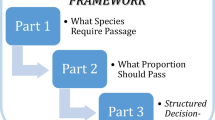Abstract
A logical sequence of seven steps is proposed as a generic template to design plans for monitoring and evaluating fish and wildlife in the Columbia River ecosystem. Management programs for these resources fail to include coordinated monitoring and evaluation plans. This short-coming is indicative of pervasive management conflicts detected from regional to local geographic scales. In the absence of a cohesive ecological management framework, monitoring and evaluation activities proceed without a clear understanding of what uncertainty they are intended to address, nor is there a clear description of the process to utilize the information gained. As a result, the accountability for the investment of public funds for fish and wildlife restoration is poor, information collected from the environment is not included in decision-making, and the ability to gain knowledge while taking management actions is compromised. The sequence of steps discussed here does not identify or describe distinct monitoring activities or methodologies at any particular location or listed under any specific monitoring plan. Instead, it concentrates on the generic elements necessary for the design and implementation of coordinated fish and wildlife monitoring plans. It is proposed that at least four major issues demand considerable attention in order to improve regional monitoring and evaluation capabilities: The first is adoption of an ecological framework for the management of fish and wildlife at relevant geographic scales within the ecosystem. Such a framework must include an explicit identification of goals, objectives, and actions to steer coordinated decisions across the boundaries of technical disciplines, management jurisdictions, and institutional responsibilities. The second is that the identification of these management goals for the geographic location of interest must precede the design of monitoring and evaluation plans from the top down. Third, the evaluation component must be considered early on in the planning process, so that it blends smoothly with monitoring at the time of implementation. Fourth, decision-makers and scientists engaged in the planning of fish and wildlife monitoring and evaluation efforts in the region must have a close collaborative relationship. Monitoring and evaluation plans designed under these premises may enhance our collective observational capabilities, promote cost-effectiveness and adequate evaluation, and provide a useful tool to adjust our management practices to the challenges of complex ecosystems.
Similar content being viewed by others
Author information
Authors and Affiliations
Rights and permissions
About this article
Cite this article
BISBAL, G. Conceptual Design of Monitoring and Evaluation Plans for Fish and Wildlife in the Columbia River Ecosystem. Environmental Management 28, 433–453 (2001). https://doi.org/10.1007/s002670010235
Issue Date:
DOI: https://doi.org/10.1007/s002670010235




